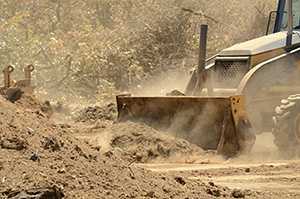COCCIDIOIDOMYCOSIS (VALLEY FEVER)

Prevention in a work setting
NIOSH recommendations in workplace health hazard evaluations have paralleled those of the California Department of Public Health (CDPH, who have produced a useful fact sheet that provides comprehensive recommendations for minimizing dust exposure and risk of coccidioidomycosis for those working in endemic areas.1
Recommended controls include:
- Stopping work in dust storms or high winds
- Minimizing hand digging and favoring digging with heavy equipment having enclosed, air-conditioned, HEPA-filtered cabs
- Continuously wetting soil while digging or moving earth
- Staying upwind of digging, when possible.
It is important that workers understand the potential hazards related to their work and how to protect themselves. OSHA’s Hazard Communication Standard, also known as the “Right to Know Law” [29 CFR 1910.1200] requires that employees are informed and trained of potential work hazards and associated safe practices, procedures, and protective measures.
CDPH recommends that workers and supervisors be provided training on the following1
- Endemic areas
- Symptoms and when to report them
- Those at highest risk of serious disease
- Effective controls
Respiratory protection is recommended for those who:
- Dig manually
- Dig using equipment (including enclosed heavy equipment)
- Work near earth-moving trucks or equipment in endemic areas.
Respirators for employees should be certified by NIOSH and provided within the context of a comprehensive respiratory protection program, which includes:
- Medical clearance for use of respirators,
- Initial and periodic training and fit testing
- Monitoring the effectiveness of the respirators
The Occupational Safety and Health Administration respiratory protection standard describes the components of a comprehensive respiratory protection program [29 CFR 1910.134]. Because as little as one spore may transmit disease, when potential exposure to dust is unavoidable, the employer should assess the associated risk and determine the level of respiratory protection needed based on the effectiveness of the various types of respirators for particles of dusts and spores. Respirator information can be found on the NIOSH website at http://www.cdc.gov/niosh/topics/respirators/. CDPH1 and Das et al.2 note that a fit tested half-mask respirator with particulate filter or a filtering facepiece respirator might be insufficient to protect the worker. Some workers, such as those with beards, cannot wear tight-fitting respirators. Loose-fitting powered air-purifying respirators are an option in that situation.
It is recommended that employers:
- Wash equipment before it is moved offsite
- Provide lockers and require that workers change clothing and shoes at the worksite so they don’t take dust and spores home
- Arrange for prompt medical evaluation and treatment of those with possible disease.
References
- California Department of Public Health (CDPH) [2013]. Preventing work-related coccidioidomycosis (Valley Fever) [http://www.cdph.ca.gov/programs/hesis/documents/CocciFact.pdf]. Date accessed: October 6, 2014
- Das R, McNary J, Fitzsimmons K, Dobraca D, Cummings K, Mohle-Boetani J, Wheeler C, McDowell A, Iossifova Y, Bailey R, Kreiss K, Materna B [2012]. Occupational coccidioidomycosis in California: outbreak investigation, respirator recommendations, and surveillance findings. J Occup Environ Med. 2012 May;54(5):564-71. doi: 10.1097/JOM.0b013e3182480556. PubMed PMID: 22504958.
- Page last reviewed: April 1, 2015
- Page last updated: April 1, 2015
- Content source:
- National Institute for Occupational Safety and Health Respiratory Health Division


 ShareCompartir
ShareCompartir